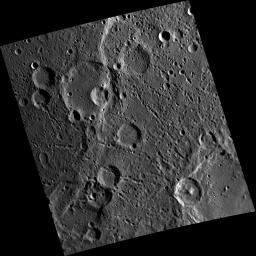Pourquoi Pas Rupes cuts dramatically through a crater in the upper left portion of this image. This rupes was named for the French ship Pourquoi Pas (which translates to "why not" in English), captained by Jean-Baptiste Charcot to explore the Antarctic region from 1908-1910. Check out MDIS images of other rupes, such as Beagle and Endeavour.
This image was acquired as part of MDIS's high-resolution stereo base map. The stereo base map is used in combination with the surface morphology base map to create high-resolution stereo views of Mercury's surface, with an average resolution of 250 meters/pixel (0.16 miles/pixel or 820 feet/pixel) or better. During MESSENGER's one-year mission, the surface morphology base map is acquired during the first 176 days, and the second 176 days are used to acquire the complementary stereo base map, which includes the image here.
The MESSENGER spacecraft is the first ever to orbit the planet Mercury, and the spacecraft's seven scientific instruments and radio science investigation are unraveling the history and evolution of the Solar System's innermost planet. Visit the Why Mercury? section of this website to learn more about the key science questions that the MESSENGER mission is addressing. During the one-year primary mission, MDIS is scheduled to acquire more than 75,000 images in support of MESSENGER's science goals.
Date acquired: October 20, 2011
Image Mission Elapsed Time (MET): 227593205
Image ID: 908832
Instrument: Narrow Angle Camera (NAC) of the Mercury Dual Imaging System (MDIS)
Center Latitude: -54.77°
Center Longitude: 211.1° E
Resolution: 245 meters/pixel
Scale: The large crater being crossed by Pourquoi Pas Rupes is 75 kilometers (47 miles) in diameter
Incidence Angle: 76.0°
Emission Angle: 28.7°
Phase Angle: 82.5°
These images are from MESSENGER, a NASA Discovery mission to conduct the first orbital study of the innermost planet, Mercury. For information regarding the use of images, see the MESSENGER image use policy.

 Planetary Data System
Planetary Data System












